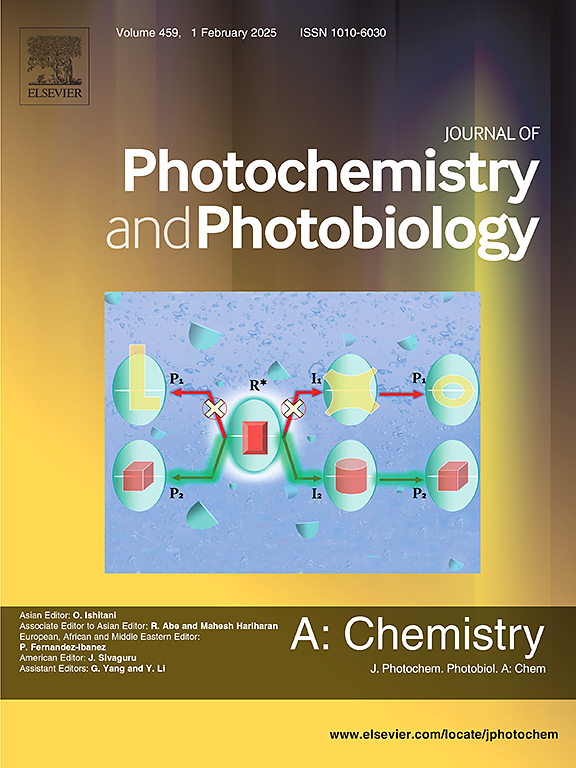Carbon dots derived from an aminonaphthalene sulfonic acid as sensitive activated fluorescent probes for chemosensing and imaging applications
IF 4.7
3区 化学
Q2 CHEMISTRY, PHYSICAL
Journal of Photochemistry and Photobiology A-chemistry
Pub Date : 2025-06-24
DOI:10.1016/j.jphotochem.2025.116570
引用次数: 0
Abstract
The presence of toxic residues in water and food is a constant concern that requires the development of fast and low-cost analytical methods for controlling and monitoring environmental conditions and physicochemical processes. In this context, the current study examines the physical and chemical properties of carbon dots (CD-ANS) produced through hydrothermal synthesis using 5-amino-2-naphthalenesulfonic acid (ANS) as a precursor. Different experimental techniques are used to characterize CD-ANS’s shape and photoluminescent properties. Our results show that such carbon dots are co-doped with nitrogen and sulfur, displaying a broad emission spectrum sensitive to small environmental changes. In particular, CD-ANS exhibits an activated fluorescence in the presence of certain organic pollutants, thus being suitable for various chemosensing applications, including ratiometric sensing of pH, methanol, and a carbamate pesticide (methomyl). Thermal effects on the nanoparticle’s photoluminescence are also analyzed, where the occurrence of a thermally-activated mechanism is identified. The possibility of using CD-ANS in staining yeast cells has also been investigated. These findings suggest that the carbon dots derived from ANS can be a versatile fluorescent platform for various physical, chemical, and biological applications.

从氨基萘磺酸衍生的碳点作为化学传感和成像应用的敏感激活荧光探针
水和食物中有毒残留物的存在是一个持续关注的问题,需要发展快速和低成本的分析方法来控制和监测环境条件和物理化学过程。在此背景下,目前的研究考察了以5-氨基-2-萘磺酸(ANS)为前体通过水热合成生产的碳点(CD-ANS)的物理和化学性质。采用不同的实验技术来表征CD-ANS的形状和光致发光特性。我们的研究结果表明,这种碳点与氮和硫共掺杂,显示出对小环境变化敏感的宽发射光谱。特别是,CD-ANS在某些有机污染物存在时表现出活化的荧光,因此适用于各种化学传感应用,包括pH,甲醇和氨基甲酸酯农药(灭多灵)的比例传感。还分析了热效应对纳米粒子光致发光的影响,其中确定了热激活机制的发生。使用CD-ANS染色酵母细胞的可能性也进行了研究。这些发现表明,从ANS衍生的碳点可以作为多种物理,化学和生物应用的多功能荧光平台。
本文章由计算机程序翻译,如有差异,请以英文原文为准。
求助全文
约1分钟内获得全文
求助全文
来源期刊
CiteScore
7.90
自引率
7.00%
发文量
580
审稿时长
48 days
期刊介绍:
JPPA publishes the results of fundamental studies on all aspects of chemical phenomena induced by interactions between light and molecules/matter of all kinds.
All systems capable of being described at the molecular or integrated multimolecular level are appropriate for the journal. This includes all molecular chemical species as well as biomolecular, supramolecular, polymer and other macromolecular systems, as well as solid state photochemistry. In addition, the journal publishes studies of semiconductor and other photoactive organic and inorganic materials, photocatalysis (organic, inorganic, supramolecular and superconductor).
The scope includes condensed and gas phase photochemistry, as well as synchrotron radiation chemistry. A broad range of processes and techniques in photochemistry are covered such as light induced energy, electron and proton transfer; nonlinear photochemical behavior; mechanistic investigation of photochemical reactions and identification of the products of photochemical reactions; quantum yield determinations and measurements of rate constants for primary and secondary photochemical processes; steady-state and time-resolved emission, ultrafast spectroscopic methods, single molecule spectroscopy, time resolved X-ray diffraction, luminescence microscopy, and scattering spectroscopy applied to photochemistry. Papers in emerging and applied areas such as luminescent sensors, electroluminescence, solar energy conversion, atmospheric photochemistry, environmental remediation, and related photocatalytic chemistry are also welcome.

 求助内容:
求助内容: 应助结果提醒方式:
应助结果提醒方式:


